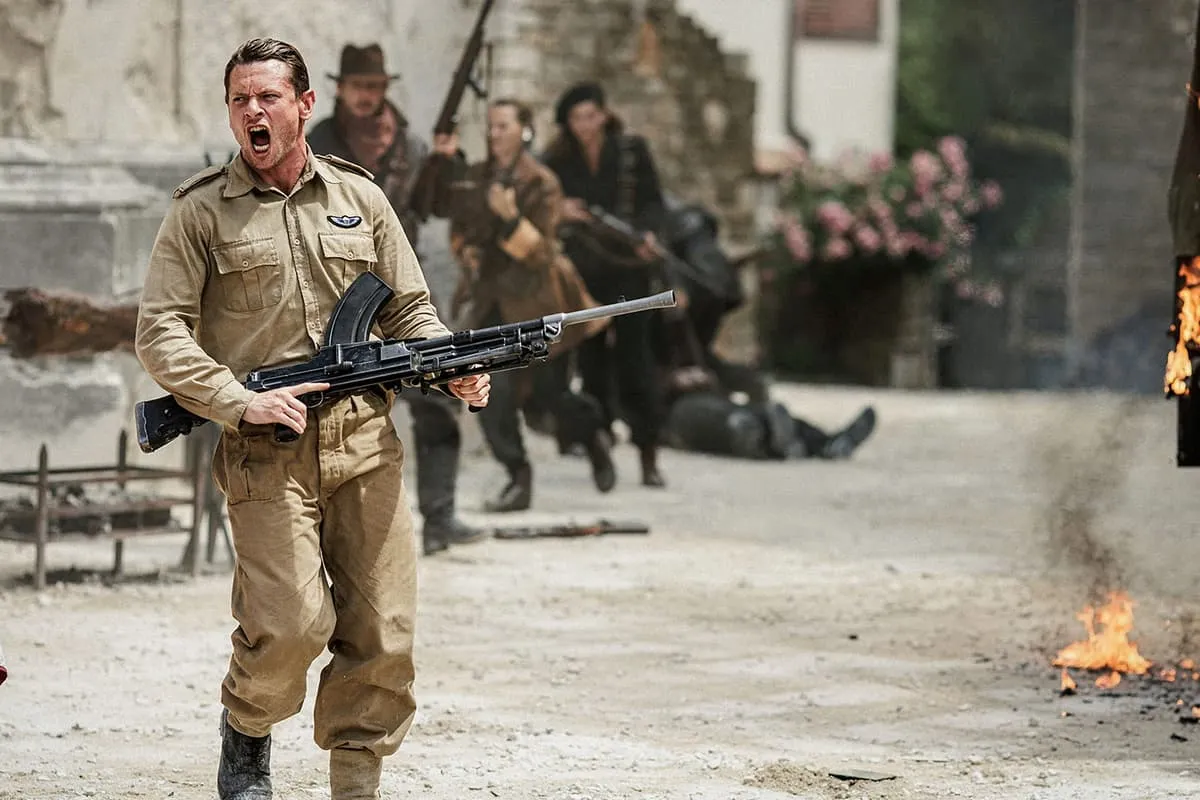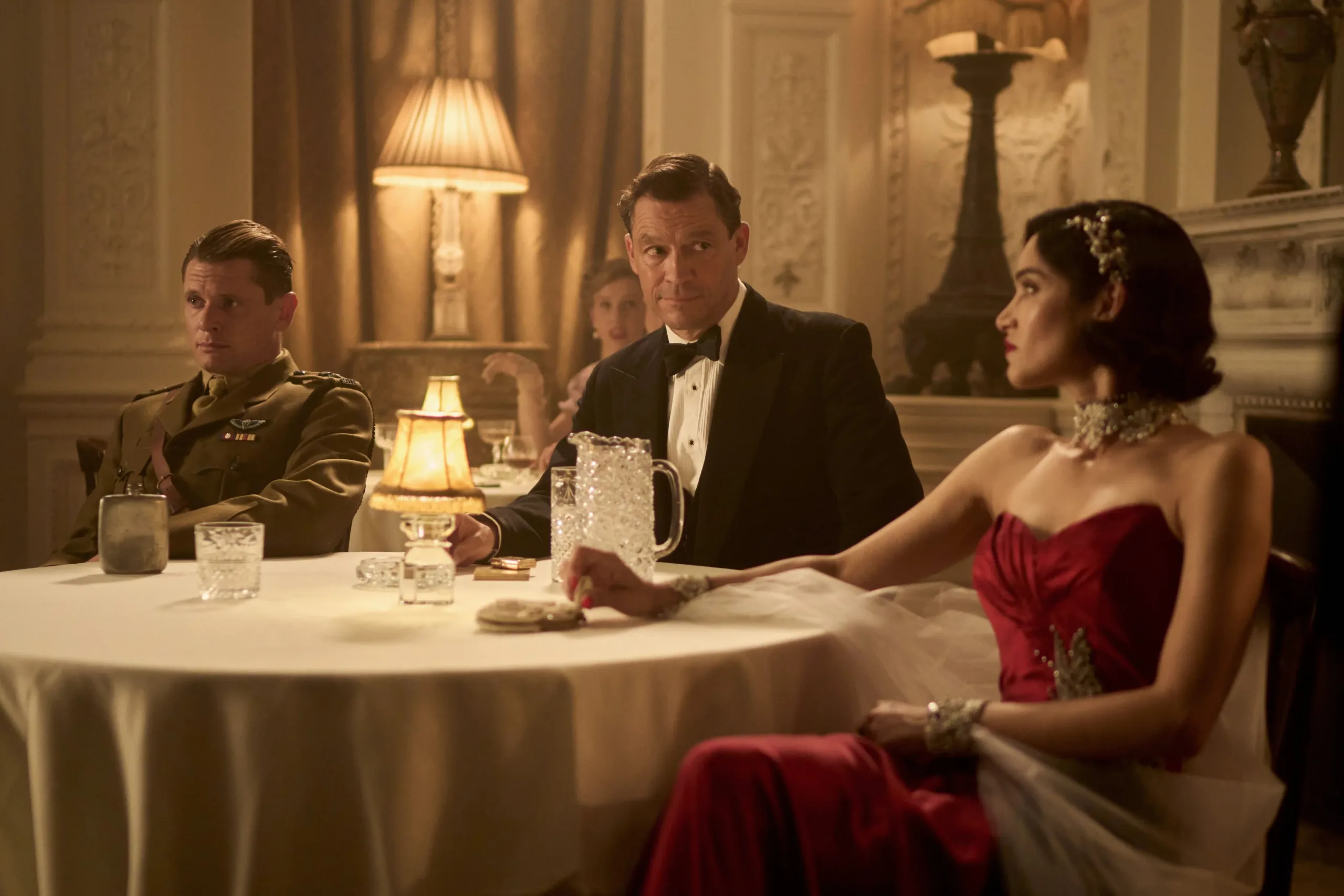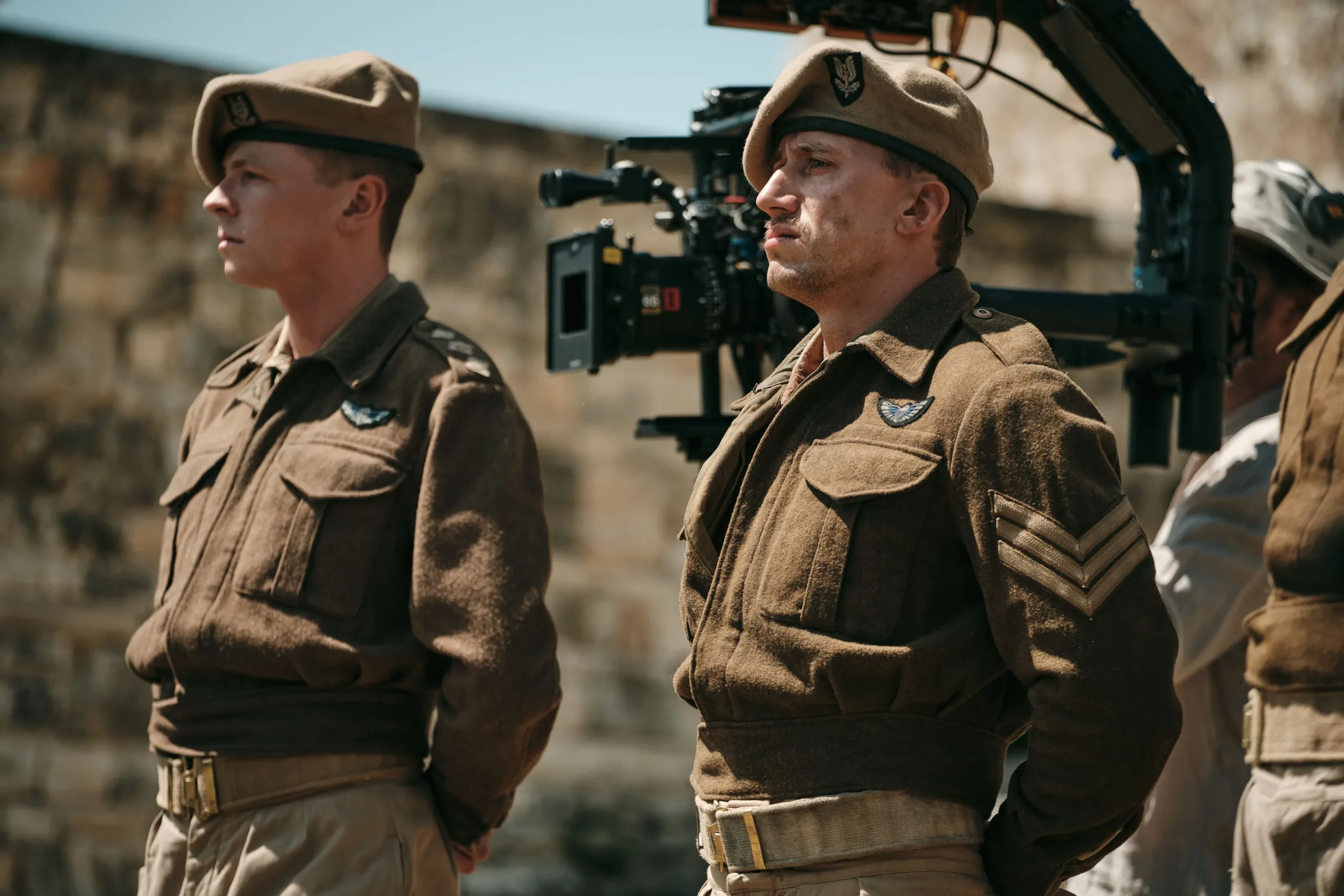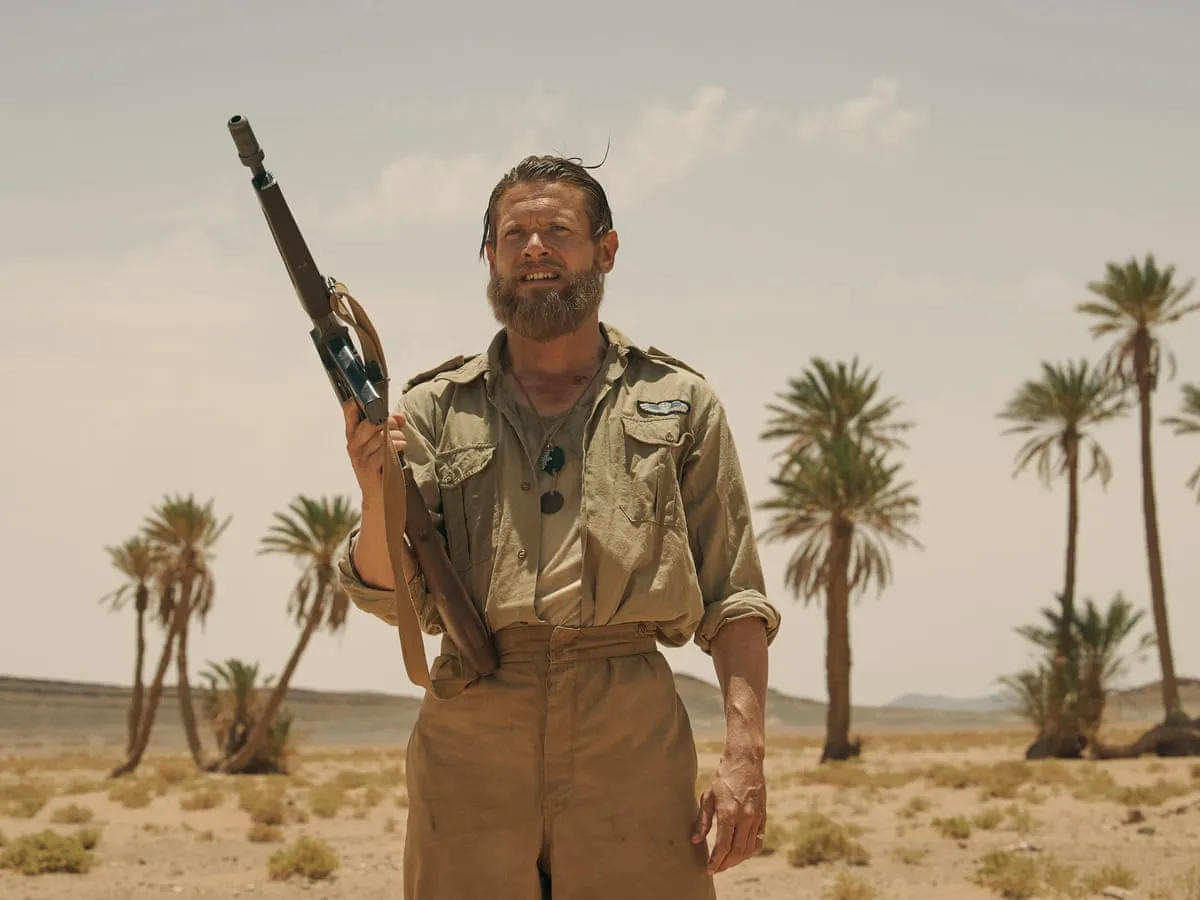Steven Knight created “SAS Rogue Heroes,” a unique wartime drama that mixes facts with a cinematic flair. Audiences were captivated by the show’s first season, which was praised for its vivid depiction of the top British regiment’s early adventures in North Africa. Not only did the series receive positive reviews from critics, but it also started discussions about the representation of military themes in modern media. As Season 2 progresses, viewers get more and more excited to see how the narrative will evolve and what new points of view it will bring.
The shift from David Stirling, portrayed by Connor Swindells, to Paddy Mayne, who Jack O’Connell fervently played, marks a significant shift in the series’ main themes. Mayne appears as a raw, impulsive force, challenging conventional notions of heroism, unlike Stirling, who embodied a cool, calculated leader. This change reflects a larger societal shift toward emphasizing authenticity and complexity over stereotypical representations of masculinity.
The series invites a deeper exploration of the moral ambiguities faced by soldiers as the setting shifts from the hot deserts of North Africa to the rough landscapes of Italy, not only changing the geographical backdrop. This change in setting enables a more detailed analysis of the psychological toll of war, in line with current conversations about mental health and the scars that soldiers carry without being seen. The series explores themes of leadership and responsibility by putting Mayne at the center, questioning what it means to be a hero in troubled times.
The Complex Tapestry of Character Development in “SAS Rogue Heroes” Season 2
A masterclass in navigating the turbulent waters of leadership under pressure is provided by Jack O’Connell’s performance as Paddy Mayne. The narrative follows Mayne’s internal fight to take authority as he moves from being a careless second-in-command to the main character.
This theme resonates with modern conversations about leadership and vulnerability. Mayne has a lot of energy and hidden fears, and O’Connell shows that by balancing moments of bravado with moments of introspection. This complex performance reflects a shifting cultural narrative that increasingly embraces flawed, complex characters, challenging the traditional idea of the unbreakable war hero.
Connor Swindells’ David Stirling, on the other hand, is relegated to a supporting part and locked up as a prisoner of war. This choice of narrative is both a bold statement and a moving commentary on the reality of conflict, showing how even the most charismatic leaders can be pushed to the sidelines by circumstances. The limited presence of Stirling serves as a reminder of how unstable power and choice are during wartime, which successfully shows how sad his character’s situation is. His detention not only takes away his freedom but also underscores the larger themes of sacrifice and the human cost of war, which are still very much present in modern discussions about military actions.
Another layer of complexity is added to the narrative with the introduction of Bill Stirling, portrayed by Gwilym Lee. A different kind of leadership can be seen in Bill, who is both practical and strict, trying to bring order out of chaos. As their opposing philosophies clash, reflecting social shifts toward inclusivity and questioning authority, the conflict between Paddy and Bill is fraught with tension. This interplay not only enriches the character arcs but also serves as a microcosm of the changing conversations about leadership styles in both the military and civilian settings, making viewers think about the benefits and pitfalls of each.
With characters like Eve Mansour and newbies like John Tonkin offering different viewpoints on the war’s ethical complexities, the supporting cast further enriches the narrative tapestry. By challenging the frequently male-dominated discourse of military heroism, Eve, a resourceful French agent, exemplifies the underrepresented voices in conventional wartime tales.
Audiences are reminded that soldiers are not just parts of a war machine, but also people who are facing difficult moral choices by Tonkin’s character, who offers novel insights into the human experience of conflict. This multilayered representation is part of a larger trend in television, where different narratives are increasingly seen as important to the storytelling landscape, reflecting a society that values complexity over simplicity.
Navigating Chaos: The Plot and Structure of “SAS Rogue Heroes” Season 2
While Season 2 of “SAS Rogue Heroes” takes place in the troubled year 1943, the special unit goes through a big change when they change their name to the Special Raiding Squadron. This shift serves a useful military purpose and represents a larger narrative evolution that reflects the chaotic and frequently ridiculous realities of war.
The main plotlines evolve around Paddy Mayne’s rise to leadership amid the difficulties of keeping the team together and dealing with existential threats on the European front. The series weaves together personal issues with bigger historical moments to highlight the human cost of the glory that is often associated with military bravery as it navigates the brutalities of war.
Season 2’s pacing is both good and bad, and this is especially clear in the first episode’s setting. This intentional pacing eventually serves to deepen the viewer’s engagement with the characters, even though the first half may feel like it’s treading water, laden with character dynamics and exposition. While the action is going on, the balance between high-octane scenes and character growth becomes clearer.
The expectation for quick-fire storytelling is countered by moments of reflection that enable audiences to grapple with the moral complexities of the characters’ choices. This juxtaposition is emblematic of a larger trend in television. This narrative choice makes viewers think about both the thrill of the mission and the emotional toll it takes on those participating.
Important fights, like the risky landing in Sicily, are acted out with cinematic flair, but they also have an emotional weight that goes beyond mere spectacle. The characters are forced to face the harsh facts of war in these scenes, which are not just action-packed sequences but also laden with moral questions that plague the characters. For example, the part where Mayne’s team has to ignore the cries of friends who are drowning makes you feel a deep sense of loss and guilt.
Such narrative choices show a shift in society toward acknowledging the darker sides of war and rejecting the idealized representations of heroism that were common in the past. By incorporating these emotional threads into the story, “SAS Rogue Heroes” entertains and starts a conversation about sacrifice, loyalty, and what it means to be human during war.
Unpacking the Themes and Motifs in “SAS Rogue Heroes” Season 2
A nuanced exploration of leadership, especially through the characters of Paddy Mayne and Bill Stirling, is at the heart of Season 2 of “SAS Rogue Heroes.” Mayne shows visceral bravery by choosing on the spot based on strong feelings. Traditional ideas of heroism are challenged by his method, which suggests that real bravery often mixes with chaos. Bill Stirling, on the other hand, has a more disciplined and strategic way of thinking.
He is an example of a different kind of bravery, requiring him to deal with the rigidities of military authority while still being close to the men he leads. The complexities of authority and the balance between assertiveness and empathy are topics of current societal discussion, and this duality of leadership reflects these issues. The series quietly criticizes the idea that recklessness is the same as valor in a world that is becoming more aware of the pitfalls of toxic masculinity.
The narrative is full of moral conundrums that make the characters and the audience deal with the emotional and moral problems of war. One especially disturbing scene is when Mayne’s squad has to sail past British soldiers who are dying, which shows how cruel military orders can be. This scene resonates deeply in today’s world, where debates over the morality of war and the human cost are more visible than ever.
It underscores soldiers’ internal struggles and challenges audiences to grapple with the reality that heroism can sometimes mix with regret and moral doubt. The series reflects a cultural shift by examining these tough decisions, moving away from idealized depictions of combat and toward a more realistic narrative of sacrifice.
The series looks at friendship in the middle of chaos through the dynamic of class within the SAS as a critical lens. Through their interactions, the characters show how class differences still exist even when a shared enemy exists. Paddy Mayne comes from the working class, while Bill Stirling comes from the upper class, creating tension that shows the complexities of loyalty and brotherhood during wartime.
In a time when issues of representation and equity are becoming more prominent, this exploration of social stratification is especially important. The series shows how class distinctions can blur conflict, encouraging understanding and solidarity among people from different backgrounds as the characters forge bonds forged in shared hardship. Ultimately, “SAS Rogue Heroes” entertains and makes people think about the complicated connections that make up human experience in tough situations.
The Stylistic Choices of “SAS Rogue Heroes” Season 2
Making Season 2 of “SAS Rogue Heroes” look the way it does is a big part of putting fans in the chaotic world of wartime Europe. Both the stark beauty and the harsh truths of the landscapes are captured in the filming. Croatia, which stands in for Italy, adds to the series’ mood with its rough terrain and old buildings.
This choice of settings gives the narrative a sense of realism and mirrors the characters’ rocky journeys, reflecting their internal conflicts against the backdrop of an epic and personal war. Rich color palettes and dark, tense moments in the film raise the emotional stakes and help audiences feel the gravity of the characters’ experiences.
The series’ irreverent tone is perfectly complemented by the rock music, which gives it a feeling of young rebellion and frantic energy. Moments of violence are transformed into thrilling spectacles by adding classical music, which gives action scenes momentum.
But it’s in the quieter scenes where the music really brings out the emotions, bringing out the characters’ weaknesses and moral problems. This juxtaposition of fast-paced beats with quieter moments reflects a larger trend in television where soundtracks play an active role in telling stories and influencing how people think and feel.
With distinctive elements like freeze frames and stylized graphics throughout the narrative, the director’s choices further distinguish “SAS Rogue Heroes.” These methods add style and make a point about how chaotic war is by creating a disorienting effect similar to what the characters are experiencing.
Archival footage gently reminds viewers of the historical background, blurring the lines between dramatization and reality. These daring stylistic choices are emblematic of new television trends that value visual storytelling and cutting-edge techniques, challenging traditional formats and encouraging audiences to interact with the content on various levels.
The Entertainment Value of “SAS Rogue Heroes” Season 2
Season 2 of “SAS Rogue Heroes” skillfully balances high-octane action with character growth, creating an interesting viewing experience that reflects an advanced knowledge of narrative pacing. The series does a great job of choreographing exciting action scenes that aren’t just for show; they’re deeply connected to the characters’ emotional journeys.
The characters’ inner battles, where the tension of combat is balanced with personal stakes, feel viscerally expressed in each task. The series goes above and beyond normal wartime fare thanks to the interplay between action-packed action and complex drama that makes viewers care about the characters. Audiences are kept on the edge of their seats by the fast-paced action, which reminds them that heroes often have a high price.
The series’ pacing is deliberate and dynamic, allowing for moments of introspection amid the chaos. Audiences are drawn into a world where tension and friendship are simmering beneath the surface thanks to this thoughtful structure, which increases viewer involvement.
A cliffhanger at the end of the season teases future episodes and makes people eager to see what happens next. This trend of strategically placed cliffhangers not only builds a loyal fan base but also exemplifies a larger industry shift toward serialized storytelling, where each show is made to keep audiences coming back for more, blurring the lines between television and movies.
Conclusion and Future Prospects of “SAS Rogue Heroes” Season 2
Season 2 of “SAS Rogue Heroes” excels in its rich character arcs and thematic depth, successfully exploring the complexities of leadership, moral dilemmas, and class dynamics within the dynamic of war.
Audiences are captivated by the series’ visual style and creative storytelling techniques, increasing its impact and striking a balance between thrilling action and moving drama. This season entertains and encourages thoughtful consideration of current social problems, making it a standout in the genre.
When you look ahead, there are many possible plots. Exploring the psychological toll of war could deepen as the characters continue to evolve, providing fertile ground for examining the long-term effects of war.
The series may also challenge conventional storytelling conventions by hints of expanding the narrative to include more diverse points of view, paving the way for a more inclusive representation of history and heroism. People are interested in these events and excited about what will happen next because they are exciting to watch.
The Review
SAS Rogue Heroes Season 2
"SAS Rogue Heroes" Season 2 expertly weaves action and character development, providing a nuanced exploration of leadership, moral dilemmas, and class dynamics against the backdrop of World War II. Its innovative storytelling, striking visuals, and captivating soundtrack elevate it above conventional war dramas, making it a gripping watch that resonates with current social issues. The series strikes a good balance between fun and serious thought as it paves the way for subsequent narratives.
PROS
- Engaging character development and arcs.
- Strong balance of action and emotional depth.
- Innovative visual style and cinematography.
- Effective use of a rock soundtrack to enhance the narrative.
- Thought-provoking exploration of moral dilemmas and societal issues.
CONS
- Some pacing issues, particularly in the early episodes.
- The portrayal of secondary characters could be more developed.
- Occasional reliance on genre tropes.





















































